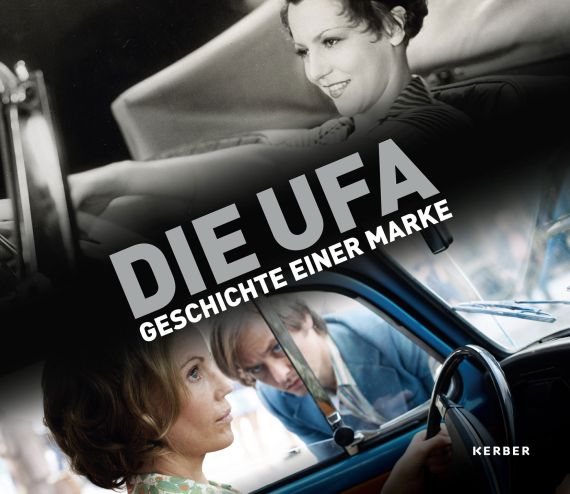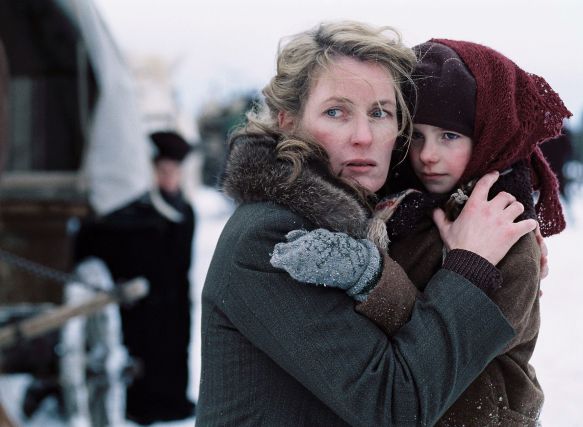
Maria Furtwängler and Stella Kunkat in Die Flucht (G 2007, directed by Kai Wessel)
© ARD Degeto / UFA / Conny Klein
Ufa – The History of a Brand
24.11.17 – 22.4.18
-
Publikation
For Ufa’s one hundredth anniversary, the Deutsche Kinemathek – Museum für Film und Fernsehen presented the eventful story of the company and brand in seven chapters. Founded during World War I as a propaganda arm, the concern has by now evolved into a “content producer” for various audio-visual platforms.
Hence, the story of Ufa also tells the story of audio-visual media. One constant thread running through the brand’s story has always been the stars, whom the company frequently claims as “its own.” Popular entertainment productions are targeted at the international market, which has proven indispensable in refinancing prestigious productions. Now called “high-end drama” in view of the global market, big-budget productions are only possible on the basis of that mixed calculation. Content from (mostly German) history has played a major role–then as now.
Despite the corporate story’s multiple breaks and ruptures, the brand “Ufa” has been in existence for one hundred years. The catchy moniker has stuck over the decades–due in no small part to its charm having made the brand an early and enduring asset.
Key Aspects
1917–1929
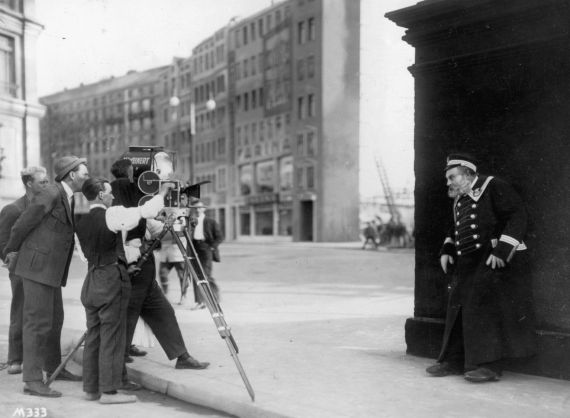
Friedrich Wilhelm Murnau, N.N., Emil Jannings, behind the scenes The Last Laugh (G 1924, directed by F. W. Murnau)
Photo: Hans Natge, source: Deutsche Kinemathek
Universum Film AG was founded in December 1917 with a mission to make the German Reich’s war propaganda more effective. One year later, Germany was on the road to democracy. Backed by a generous supply of capital from industry and Deutsche Bank, Ufa persisted and started drawing international attention with epic films like Ernst Lubitsch’s Madame Dubarry (1919). The company was vertically structured: production sites– including the Babelsberg Studios, which Ufa took over in 1922–a distribution division, and cinemas all operated under the Ufa rhombus logo.
In the mid-1920s, Ufa got into financial trouble with ambitious productions like Fritz Lang’s Metropolis. The conservative nationalist “Media Czar” Alfred Hugenberg saved the day in 1927 by purchasing the company and having it restructured and modernized by trusted associate Ludwig Klitzsch. The construction of a new studio complex laid out in the shape of a cross in 1929 marked Ufa’s investment in a technological innovation and media revolution: talkies.
1930–1949
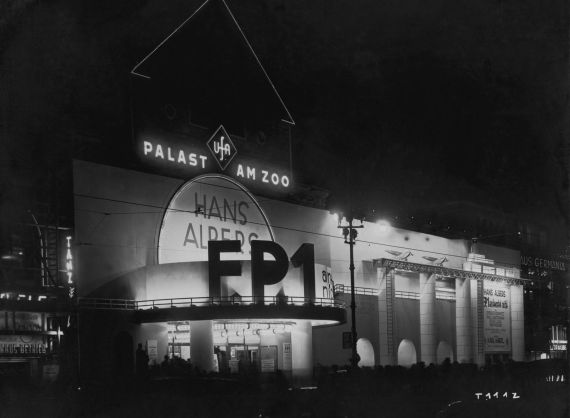
Ufa-Palast am Zoo, Berlin, December 1932
Source: Deutsche Kinemathek
Despite a worldwide economic crisis and mass unemployment, Ufa was thoroughly successful in the early 1930s. Talkie operettas like Die Drei von der Tankstelle (1930, directed by Wilhelm Thiele) gave audiences a temporary escape from everyday life, and conservative pro-Prussia and other patriotic films were produced – entirely along Alfred Hugenberg’s lines.
The company conformed quickly with the National Socialist dictatorship, firing Jewish colleagues and premiering Hitlerjunge Quex (1933, directed by Hans Steinhoff) in Adolf Hitler’s presence. Ufa continued to produce and distribute entertainment and propaganda vehicles, and the company was nationalized in 1937. During the Second World War, its empire stretched over the territories under German occupation. Minister of Propaganda Joseph Goebbels consolidated the entire German film industry under the name Ufa Film GmbH (Ufi) in 1942. Ufa’s last big production was Veit Harlan’s 1944 morale-booster Kolberg.
One year after the war’s end, Deutsche Film AG (DEFA) was founded in the Soviet Zone; DEFA would operate the Babelsberg Studios from that point on. The Western Allies attempted to prevent a resurrection of Ufa through legislation.
1950–1969
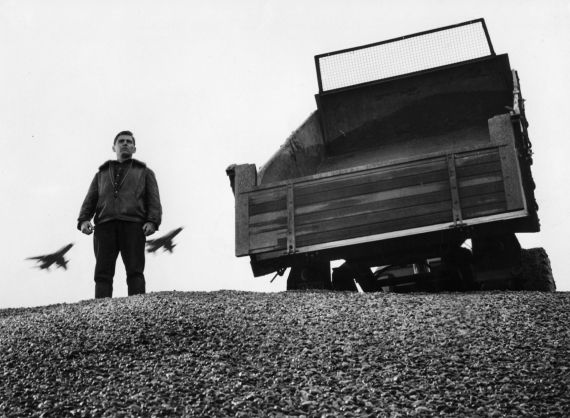
Black Gravel (FRG 1961, directed by Helmut Käutner)
Source: Deutsche Kinemathek
The laws passed to break up the Ufi concern were undermined in West Germany, likely with the support of Konrad Adenauer’s government. From the fragmentation of the film studios and cinema park to the decreed ban on the Ufa name, ultimately none of the key initiatives found long-term implementation. Instead, Universum Film AG was re-incorporated, privatized, and recommenced producing films under the rhombus logo in 1956. Deutsche Bank once again supplied the founding capital. Among the leadership and the creative personnel, there were multiple hold-overs from the Nazi era.
Despite all the restructuring, post-war Ufa didn’t fare well during the cinema crisis of the late 1950s: by that time, television had become the new medium to watch. In 1964, Ufa was sold to Bertelsmann, whose initial interest was in the incidental music rights. With Ufa Film- und Fernseh-GmbH, however, they were set to invest in a new market.
1970–1989
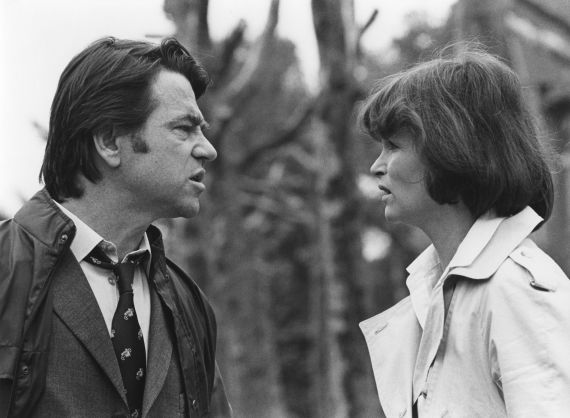
Die zweite Haut (FRG 1981, directed by Frank Beyer)
Source: Deutsche Kinemathek
TV screens may still have been small, but the shows they brought into living rooms enjoyed outspoken and widespread popularity. Ufa’s television productions presented broadcasters with the whole gamut of mainstream entertainment genres and formats: from music show to literary adaptation, period piece to family series.
While Ufa-Filmproduktion was working with West Berlin cabaret star Dieter Hallervorden on slapstick comedies for cinemas – the subsidiary had in fact been founded for this very purpose – about a dozen East German DEFA stars came to Ufa-Fernsehproduktion, also based in Berlin. Many of them either wanted or had to leave the GDR after singer-songwriter Wolf Biermann was expatriated. Directors such as Frank Beyer, authors including Jurek Becker, Günter Kunert, and Klaus Poche, DEFA stars Manfred Krug, Hilmar Thate, Angelica Domröse, etc. made critically charged current affairs pieces for West German TV, earning new respect for Ufa-Fernsehproduktion with the networks.
1990–2009
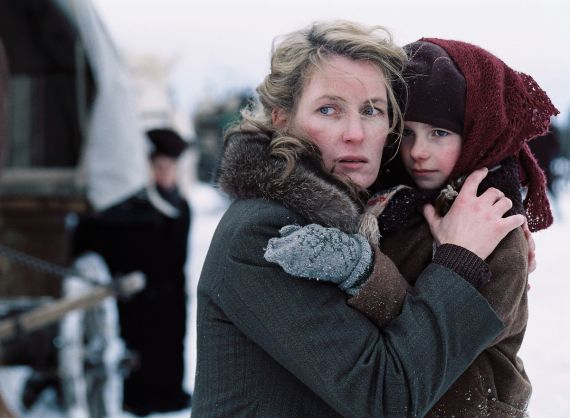
Maria Furtwängler and Stella Kunkat in Die Flucht (G 2007, directed by Kai Wessel)
© ARD Degeto / UFA / Conny Klein
The 1984 introduction of private broadcasting in Germany eventually paid off for UFA in the long run: After ten years in existence, RTL and Sat.1 had grown regular audiences sizable enough that commercial slots brought in money. The networks then invested a portion of that income in programming innovations, be it in the interest of securing their established market position or in an effort to polish up private TV’s image with prestigious programming stimuli.
UFA profited from both strategies: they produced daily series for RTL in the 1990s, and at the turn of the millennium, they masterminded a new miniseries spectacular format for Sat.1 with the likes of Der Tunnel (2001, directed by Roland Suso Richter) and Der Tanz mit dem Teufel (2001, directed by Peter Keglevic). Aside from that, the various subsidiaries had plenty of opportunity both for “bread and butter” business with ARD and ZDF, and for a long-term expansion into the European TV market. These years saw UFA tapping cinema markets on the side at best: the made-for-TV movie Die Polizistin (WDR 2000, directed by Andreas Dresen) was “recycled” in theaters a year after being broadcast.
2010–2017
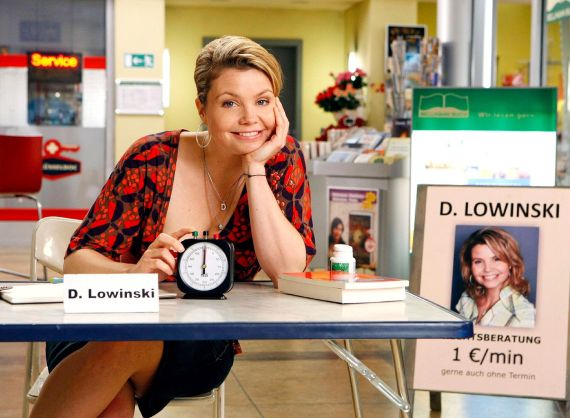
Danni Lowinski (G 2010–2014)
© Sat.1 / Frank Dicks
For some time now, TV content hasn’t only been coming to houses in a linear program. It can be accessed on an individual basis via the computer – material can be streamed regardless of fixed broadcasting hours. Because of that, UFA, now part of a worldwide media giant, has been producing and developing with an eye more and more to the international market, occasionally even filming directly in English. Aside from German network partners, potential clients now include Netflix, Amazon, and YouTube.
To better position itself within a global competition, UFA reorganized its subsidiaries and divided them into four “units,” each with an English name. Instead of made-for-TV movies for ARD and ZDF, production is now geared towards series like Deutschland 83 (2015, directed by Edward Berger / Samira Radsi) and blockbusters like Der Medicus (2013, directed by Philipp Stölzl). A unit exclusively producing content for digital media has been in operation since 2009: UFA LAB. At the same time, the UFA brand – in cooperation with Bertelsmann – remains conscious of tradition: once a year since 2012, UFA Film Nights have been presenting old silent film classics under the skies of Berlin and other cities.
UFA LAB
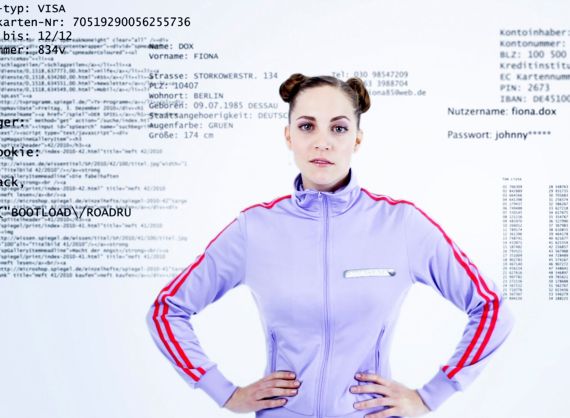
Wer rettet Dina Foxx? (G 2011, directed by Max Zeitler)
© ZDF / Florian Foest
The Digital Studio
When UFA LAB took up its work in 2009, the iPhone had been on the market for two years, and YouTube was four years old. Alongside the smartphone, which allows people to shoot and play back videos anywhere, social media and their interactive offerings have undone the old division of labor between producer and consumer. UFA responded by establishing a research and development division tasked with sounding out the new market for fields of labor and potential sources of revenue. Assignments pointed in all directions: UFA LAB devised a transmedia concept with the ZDF network that lured viewers away from the TV and onto the internet. Blogs and web series were conceived for Facebook and YouTube. Educational formats targeted at young internet users were developed for non-profit organizations. On a job for a brand-name manufacturer, an UFA LAB team traveled to Florida with a 360-degree camera system in 2015: the virtual experience of riding the boulevards of Miami in the passenger seat of a convertible was used at fairs and in showrooms for the launch of a car model. One hundred years after UFA’s founding, one thing the LAB is currently working on is “immersive film,” in which viewers feel like part of the production unfolding around them.
Gallery
Credits
Artistic director: Rainer Rother
Administrative director: Florian Bolenius
Curators: Peter Mänz, Klaudia Wick
Curatorial assistance: Maximilian Weinberg
Project management: Peter Mänz, Kristina Jaspers
Exhibition coordination: Vera Thomas
Exhibition assistance: Annika Schaefer
Scientific Advice: Rolf Aurich
Audiovisual media program: Nils Warnecke, Klaudia Wick
Text editing: Karin Herbst-Meßlinger
English translations: Carrie C. Roseland
Object photography: Marian Stefanowski, Siegmar Brüggenthies
Scans: Siegmar Brüggenthies, Julia Riedel
Design of the advertising graphics: Pentagram Design, Berlin
Design of the exhibition architecture and exhibition graphics: Franke | Steinert, Berlin
Design and realisation multimedia terminals: Franke | Steinert, Berlin
Exhibition construction and presentation: museumstechnik, Berlin
Conservational supervision: Sabina Fernández
Textile restorer and costume installations: Barbara Schröter
Paper restoration: Restaurierung Werkstatt Claus Schade, Berlin
Papierrestaurierung Atelier Caney & Siedler, Berlin
Object restoration: Bildgießerei Hermann Noack, Berlin
Photo archive: Julia Riedel
Graphic archive: Anett Sawall
Personal estates and deposited holdings: Gerrit Thies
Scripts and documents archive: Regina Hoffmann
Historical film equipment archive: Karsten Seyfert
Editing of the audiovisual media: Stanislaw Milkowski
Editing studio: Concept AV, Berlin
Television media library: Holger Theuerkauf (Archiv), Annabelle Wick (Schnitt)
Media installations: Stanislaw Milkowski (Concept AV), Ingo Nolte (PIK), Stephan Werner
Technical services: Frank Köppke, Roberti Siefert, Andreas Weiland
Assistance to the board of directors: Susanne Ruppelt, Katja Schumann
Finance: Sven Blumberg, Uwe Meder-Seidel, Gabriele Reckewitz, Sebastian Thiel, Marion Tolksdorf
Personnel office: Petra Treutler, Luisa Vollmer
Head of communications: Sandra Hollmann
Marketing: Anne Rüdiger
Press office: Anna Bockhoff, Heidi Berit Zapke
Educational services: Jurek Sehrt
Guided tours and workshops: Kulturprojekte Berlin GmbH Museumsdienst
(Gitte Hellwig, Thomas Zandegiacomo, Jörg Becker)
Lenders
Wolf Bauer, Potsdam
Bertelsmann, Gütersloh
bpk-Bildagentur, Berlin
Brody Associates
Bundesarchiv/Fotoarchiv, Berlin
Filmmuseum Potsdam/Sammlungen
Henry Foerster, Berlin
Annette Frier, Köln
FTA Film- und Theater-Ausstattung GmbH, München
Nico Hofmann, Potsdam
Knut Loewe, Berlin
Norbert Sauer, Berlin
Theaterkunst Kostümausstattung GmbH
UFA GmbH, Potsdam
ullstein bild
Stephan Wagner, Berlin
Süddeutsche Zeitung Photo, München
Lenders (Media)
Bundesarchiv – Filmarchiv, Berlin
Deutsches Filminstitut – DIF, Frankfurt am Main
Friedrich-Wilhelm-Murnau-Stiftung, Wiesbaden
Kineos GmbH, Oberhaching
Transit Film GmbH, München
Progress-Film, Berlin
BR, MDR, NDR, RBB, RTL, RTL 2, Sat.1, SWR, VOX, WDR, ZDF
Acknowledgements
Special thanks to:
Wolfgang Daschner, Joachim A. Lang, Daniel Borck (Brody Associates), Chris Ede, Susanne Franke (Theaterkunst), Marion Jenke, Christoph H. Kuhnheim, Annette Kusche (TRIAD), Frank Pick (RTL Kommunikation), Stephan Rabold, Hubert Riedel, Jumana Rizwan (FremantleMedia), Ursula Rohloff, Evi Scherrer (FTA), Maria Schicker, Birgit Scholz (Filmmuseum Potsdam), Caroline von Senden (ZDF), Georg Simbeni, Thomas Stammer, Reinold E. Thiel, Gerrit Thies, Ingrid Zoré
UFA GmbH: Ute Biernat, Janine Friedrich, Maja Genowa, Marion Jenke, Anja Käumle, Kirstin Krause, Katja Rentsch, Katharina Schwarz
UFA LAB: Christian Kosta-Zahn, Katharina Schwarz
Deutsche Telekom
Medienboard Berlin-Brandenburg
as well as to all of our colleagues at the Deutsche Kinemathek – Museum für Film und Fernsehen
Partners
The Deutsche Kinemathek is supported with funding from the
Federal Government Commissioner for Culture and the Media
Supported by
Friedrich-Wilhelm-Murnau-Stiftung
OSRAM
Dussmann das KulturKaufhaus
Yorck Kinogruppe
ARD
ZDF
RTL
SAT.1
Media partners
ARTE
Inforadio rbb
